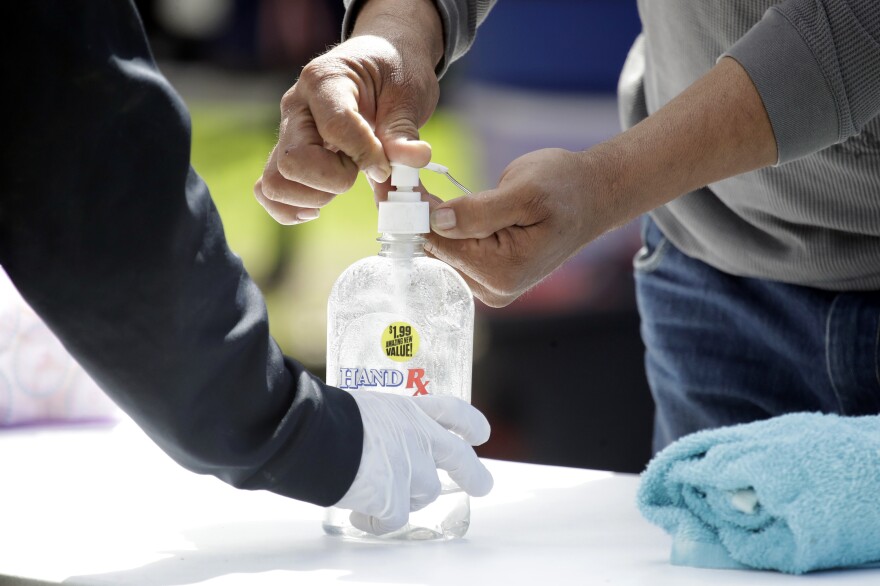For the past 16 months, Angelo Mike has been living in his beige Toyota Camry in L.A.'s San Fernando Valley. It's difficult for obvious reasons: no bed, no kitchen, no bathroom. But, Mike says, structure and organization make it manageable.
Until recently, his daily routine involved waking up by 6:00 a.m. most mornings and heading to a nearby gym. There he'd exercise and shower. If he didn't need to be on set — Mike works as a crew member on movie sets — he'd head to the library after the gym to work on his laptop and search for new gigs.
Then came the coronavirus. "Basically the only place I go now is the park," Mike says.
In order to slow the virus' spread, both the city-operated Los Angeles Public Library and the Los Angeles County Library have closed all branches at least until the end of the month. Gyms and fitness centers throughout the county are also closed. While many L.A. residents will turn to e-books or online workouts, these closures are upending daily life for the region's unhoused population.
Close to 60,000 people live on the streets or in cars or shelters in L.A. County, according to the latest count by the Los Angeles Homeless Services Authority. Like Mike, many rely on an unofficial social service network cobbled together from various places offering running water, Internet access, electrical outlets and a free or cheap place to sit. Libraries, gyms, coffee shops and fast food restaurants all help fill gaps in the social safety net.

Replacing the loss of sink and toilet access is a high priority for officials, according to Heidi Marston, interim executive director of the Homeless Services Authority, a city-county agency.
"The big thing there is just the capacity reduction for ... restrooms and hand-washing, or even just a place where people can go," she says. "Where we're losing capacity, we're spending a lot of time trying to rebuild it, so we're not losing those very critical hygiene services."
For example, the Homeless Services Authority has been working with the city to roll out hundreds of mobile toilets and sinks, prioritizing locations near large encampments with no other access to such facilities. One of these stations sits in L.A.'s Echo Park neighborhood, across the street from a freeway underpass where the sidewalks are lined with tents. It includes two portable toilets and a small sink stocked with a soap dispenser and paper towels. On a recent afternoon, security guard Josh Givens said he'd seen about 10 people an hour stopping in to use the facilities.

City, county and California state officials are working on various plans to move people experiencing homelessness indoors. That includes new emergency shelters as well as creating quarantine spaces for unhoused coronavirus patients if needed. In the meantime, the City of Los Angeles has suspended enforcement of a rule requiring people to take tents down during the day.
"The ideal solution is to provide housing and shelter and allow people to ... come indoors ..." wrote the three L.A. City Council members who introduced the tent proposal. "But, in the meantime, people remain on our streets."
For Angelo Mike, he's been mostly keeping to himself in his car or outdoors. Even if he had the opportunity to go to a shelter, he says, he's concerned about their typically close quarters due to the potential spreading of coronavirus. So instead he keeps his vehicle near a park in L.A.'s Sun Valley neighborhood — a quiet, suburban area. He's tried washing up in the park restroom but says the water is uncomfortably cold in the mornings and flows through a faucet that needs to be pressed continually.
"You can't rub your hands together," he says. "I rinse myself off in the morning with just a bottle of water now."

During the day he wears a thick pair of gardening gloves for protection, and sometimes a mask. He's able to pick up meals at a local food bank. But with no library and nowhere to charge his laptop, look for jobs or even just sit, he has time to fill. He spends a lot of it walking around the park. It helps to exercise, he says, "so I don't have this anxiety built up in me." A few times a day he calls his mom in Virginia. He's also been shooting his own mini-films on his phone and posting them to social media, documenting his experience.
"Just to show people what's going on," he says. "How am I surviving ... to make people aware [that] hey, regular people are barely getting by."
Copyright 2021 KCRW. To see more, visit KCRW. 9(MDEwMTk5OTQ0MDEzNDkxMDYyMDQ2MjdiMw004))











